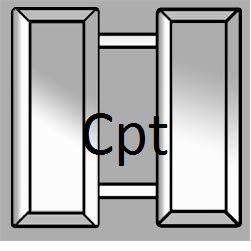Christopher I Sharp
age ~38
from Hutto, TX
- Also known as:
-
- Christopher Isaac Sharp
- Christphor Sharp
Christopher Sharp Phones & Addresses
- Hutto, TX
- New Braunfels, TX
- Austin, TX
- Dubuque, IA
- Tucson, AZ
- Phoenix, AZ
- Des Moines, IA
Resumes

Christopher Sharp
view source
Christopher Sharp
view source
Picker
view sourceWork:
Starbucks Roasting and Distribution
Picker
Picker

Christopher Sharp
view source
Actor
view sourceWork:
Actor

Christopher Sharp
view sourceLocation:
United States
Lawyers & Attorneys

Christopher G. Sharp, Austin TX - Lawyer
view sourceAddress:
Sharp & Cobos, L.L.P.
4705 Spicewood Springs Road Suite 100, Austin, TX 78759
5124732265 (Office)
4705 Spicewood Springs Road Suite 100, Austin, TX 78759
5124732265 (Office)
Licenses:
Texas - Eligible To Practice In Texas 1978
Experience:
Partner at Sharp & Cobos, LLP - 2013-present
Owner at Sharp Law Firm - 1991-present
Associate at Sharp & Cobos, LLP - 2002-2013
Associate at Michael R. Sharp , Attorney at Law - 1988-2002
Partner at Coffee, Coffee & Sharp - 1978-1991
Owner at Sharp Law Firm - 1991-present
Associate at Sharp & Cobos, LLP - 2002-2013
Associate at Michael R. Sharp , Attorney at Law - 1988-2002
Partner at Coffee, Coffee & Sharp - 1978-1991
Education:
Southern Methodist University
Graduated - 1978
University of Texas
Degree - BBA - Bachelor of Business Administration - Finance
Graduated - 1975
Graduated - 1978
University of Texas
Degree - BBA - Bachelor of Business Administration - Finance
Graduated - 1975
Specialties:
Health Care - 75%, 36 years, 1,000 cases
Real Estate - 15%, 46 years, 5,000 cases
Business - 10%, 46 years, 500 cases
Real Estate - 15%, 46 years, 5,000 cases
Business - 10%, 46 years, 500 cases
Associations:
American Bar Association, 2013-present
Austin Bar Association, 2013-present
U.S. Supreme Court, 1982-present
U.S. Court of Appeals for the Fifth Circuit, 1980-present
U.S. District Court for the Northern and Western Districts of Texas, 1980-present
Dallas Bar Association, 1978-present
Austin Bar Association, 2013-present
U.S. Supreme Court, 1982-present
U.S. Court of Appeals for the Fifth Circuit, 1980-present
U.S. District Court for the Northern and Western Districts of Texas, 1980-present
Dallas Bar Association, 1978-present
Description:
I am pleased and humbled to have been rated A-V by Martindale-Hubbell for more than 25 consecutive years.

Christopher Sharp - Lawyer
view sourceSpecialties:
Personal Injury Law
ISLN:
903815015
Admitted:
1989
University:
Southern Methodist University, B.A., 1986
Law School:
John Marshall Law School, J.D., 1989
Medicine Doctors

Christopher Sharp
view sourceSpecialties:
General Practice
Work:
Stanford Health Internal Medicine
211 Quarry Rd, Palo Alto, CA 94304
6507236028 (phone), 6504987750 (fax)
211 Quarry Rd, Palo Alto, CA 94304
6507236028 (phone), 6504987750 (fax)
Education:
Medical School
Dartmouth Medical School
Graduated: 1998
Dartmouth Medical School
Graduated: 1998
Conditions:
Alopecia Areata
Anxiety Phobic Disorders
Attention Deficit Disorder (ADD)
Bronchial Asthma
Diabetes Mellitus (DM)
Anxiety Phobic Disorders
Attention Deficit Disorder (ADD)
Bronchial Asthma
Diabetes Mellitus (DM)
Languages:
English
Description:
Dr. Sharp graduated from the Dartmouth Medical School in 1998. He works in Palo Alto, CA and specializes in General Practice. Dr. Sharp is affiliated with Stanford Hospital.

Christopher D. Sharp
view sourceSpecialties:
Anesthesiology
Work:
UT Regional One PhysiciansUT Medical Group Anesthesiology
877 Jefferson Ave STE 601, Memphis, TN 38103
9014485893 (phone), 9014485540 (fax)
877 Jefferson Ave STE 601, Memphis, TN 38103
9014485893 (phone), 9014485540 (fax)
Languages:
English
Description:
Dr. Sharp works in Memphis, TN and specializes in Anesthesiology. Dr. Sharp is affiliated with Methodist University Hospital and Regional One Health.

Christopher Stephen Sharp
view sourceIsbn (Books And Publications)


Name / Title
Company / Classification
Phones & Addresses
Owner
Circle K Stores Inc
Grocery Stores
Grocery Stores
1231 S Mesa Dr, Mesa, AZ 85210
Director
Sharp Custom Homes Inc
10900 Stonelake Blvd, Austin, TX 78759
Director
APOSTLES WAY MINISTRIES INTERNATIONAL
1351 Fm 1460, Georgetown, TX 78626
190 Reynolds Ln, Brownwood, TX 76801
190 Reynolds Ln, Brownwood, TX 76801
CS-CUBED LLC
6100 E Bellevue St APT #12, Tucson, AZ 85712
OHIO NATIONALS TRAVEL BASEBALL
C SHARP SOLUTIONS LLC
Hill Country Wood Restoration
Wood Preservatives
Wood Preservatives
1352 Becca Teal Pl, Round Rock, TX 78681
5122641835, 5123102159
5122641835, 5123102159
President, Director
DOUBLE TUFF TRUCK TARPS, INC
Mfg Tarpaulins
Mfg Tarpaulins
4909 E Cesar Chavez St STE C, Austin, TX 78702
5123853500
5123853500
Us Patents
-
Integrated System For Controlling Diesel Engine Emissions
view source -
US Patent:6615580, Sep 9, 2003
-
Filed:Sep 24, 2001
-
Appl. No.:09/961442
-
Inventors:Magdi K. Khair - San Antonio TX
Cynthia C. Webb - San Antonio TX
Gordon J. Bartley - San Antonio TX
Christopher A. Sharp - San Antonio TX -
Assignee:Southwest Research Institute - San Antonio TX
-
International Classification:F01N 300
-
US Classification:60286, 60274, 60285, 60288, 60311
-
Abstract:A method for controlling diesel engine emissions is disclosed. The diesel engines exhaust system has a diesel particulate filter (DPF) and a lean NO trap (LNT). The DPF is a filter and is monitored to determine the need for regeneration. The LNT is monitored to determine the need for regeneration or desulfurization. A fuel injector is used to inject fuel upstream of the LNT under certain conditions, and a bypass may be used to bypass exhaust around the DPF to provide richer or hotter exhaust to the LNT. The sensor outputs and controls for providing the appropriate heat or fuel mix for regeneration and desulfurization may be controlled with enhancements to existing engine control circuitry.
-
Integrated Method For Controlling Diesel Engine Emissions In Crt-Lnt System
view source -
US Patent:6718757, Apr 13, 2004
-
Filed:Jan 21, 2003
-
Appl. No.:10/347722
-
Inventors:Magdi K. Khair - San Antonio TX
Cynthia C. Webb - San Antonio TX
Gordon J. Bartley - San Antonio TX
Christopher A. Sharp - San Antonio TX -
Assignee:Southwest Research Institute - San Antonio TX
-
International Classification:F01N 300
-
US Classification:60286, 60274, 60276, 60285, 60288, 60295, 60297
-
Abstract:A method for controlling diesel engine emissions is disclosed. The diesel engines exhaust system has a NO oxidation catalyst, a diesel particulate filter (DPF), and a lean NO trap (LNT). The DPF is monitored to determine the need for regeneration. The LNT is monitored to determine the need for regeneration or desulfurization. A fuel injector is used to inject fuel upstream of the LNT under certain conditions, and a bypass may be used to bypass exhaust around the oxidation catalyst to provide richer or hotter exhaust to the LNT.
-
Noreduction System For Diesel Engines, Using Hydrogen Selective Catalytic Reduction
view source -
US Patent:7135153, Nov 14, 2006
-
Filed:Mar 7, 2002
-
Appl. No.:10/093199
-
Inventors:Gordon James Johnston Bartley - San Antonio TX, US
Christopher Alan Sharp - San Antonio TX, US -
Assignee:Southwest Research Institute - San Antonio TX
-
International Classification:B01D 53/34
-
US Classification:422168
-
Abstract:An emission control system for reducing NOin the exhaust of a diesel engine. A partial oxidation system receives diesel fuel from the engine's fuel tank and partially oxidizes the diesel fuel into hydrogen. The hydrogen is then introduced into the main exhaust line and the hydrogen-enhanced exhaust is delivered to a hydrogen selective catalytic reduction unit, which uses the hydrogen to convert the NOto nitrogen.
-
Hydrogen Selective Catalytic Reduction For No
view source -
US Patent:7163668, Jan 16, 2007
-
Filed:Feb 27, 2004
-
Appl. No.:10/788508
-
Inventors:Gordon James Johnston Bartley - San Antonio TX, US
Christopher Alan Sharp - San Antonio TX, US -
Assignee:Southwest Research Institute - San Antonio TX
-
International Classification:B01D 53/56
-
US Classification:4232391
-
Abstract:An emission control system for reducing NOin the exhaust of a diesel engine. A partial oxidation system receives diesel fuel from the engine's fuel tank and partially oxidizes the diesel fuel into hydrogen. The hydrogen is then introduced into the main exhaust line and the hydrogen-enhanced exhaust is delivered to a hydrogen selective catalytic reduction unit, which uses the hydrogen to convert the NOto nitrogen.
-
Exhaust Gas Recirculation System With Control Of Egr Gas Temperature
view source -
US Patent:7195006, Mar 27, 2007
-
Filed:Nov 29, 2005
-
Appl. No.:11/288891
-
Inventors:Magdi K. Khair - San Antonio TX, US
Yiqun Huang - San Antonio TX, US
Christopher A. Sharp - San Antonio TX, US
Cynthia C. Webb - San Antonio TX, US -
Assignee:Southwest Research Institute - San Antonio TX
-
International Classification:F02M 25/07
F02B 47/08
F02B 33/44
F28F 27/02 -
US Classification:12356812, 606052
-
Abstract:A method and system for controlling the temperature of recirculated exhaust gas in an exhaust gas recirculation (EGR) system, such as those used in connection with diesel engines. An EGR loop (which may be either a high pressure loop or a low pressure loop) has a dual-leg segment with an EGR cooler on one leg and an EGR heater on the other leg. By means of a valve, the EGR gas may be diverted to either one leg or the other, thereby providing either cooled or heated EGR gas to the engine.
-
Noreduction System For Diesel Engines, Using Hydrogen Selective Catalytic Reduction
view source -
US Patent:7357900, Apr 15, 2008
-
Filed:Sep 6, 2006
-
Appl. No.:11/470413
-
Inventors:Gordon James Johnston Bartley - San Anonio TX, US
Christopher Alan Sharp - San Antonio TX, US -
Assignee:Southwest Research Institute - San Antonio TX
-
International Classification:B01D 50/00
-
US Classification:422168
-
Abstract:An emission control system for reducing NOin the exhaust of a diesel engine. A partial oxidation system receives diesel fuel from the engine's fuel tank and partially oxidizes the diesel fuel into hydrogen. The hydrogen is then introduced into the main exhaust line and the hydrogen-enhanced exhaust is delivered to a hydrogen selective catalytic reduction unit, which uses the hydrogen to convert the NOto nitrogen.
-
No Augmentation In Exhaust Gas Simulation System
view source -
US Patent:7550126, Jun 23, 2009
-
Filed:Jan 25, 2007
-
Appl. No.:11/627122
-
Inventors:Cynthia C. Webb - San Antonio TX, US
Christopher A. Sharp - San Antonio TX, US -
Assignee:Southwest Research Institute - San Antonio TX
-
International Classification:C01B 21/20
G05D 7/00 -
US Classification:423385, 423400, 423402, 423403, 423405, 422105, 422107, 73 2331, 7311401, 7311802
-
Abstract:Various methods and systems for augmenting the amount of NOin the exhaust of an exhaust flow simulation system. These methods and system can be “combustion” or “post combustion”. A combustion embodiment injects a nitrogen-containing compound (doping agent) into the burner, so that it mixed and combusted with the fuel.
-
Cylindrical Proton Exchange Membrane Fuel Cells And Methods Of Making Same
view source -
US Patent:60015004, Dec 14, 1999
-
Filed:Jun 5, 1997
-
Appl. No.:8/869795
-
Inventors:Edward Albert Bass - San Antonio TX
Patrick Martin Merritt - San Antonio TX
Christopher Alan Sharp - San Antonio TX
Craig Marshall Wall - San Antonio TX
John Campbell - San Antonio TX -
International Classification:H01M 810
-
US Classification:429 31
-
Abstract:The present invention provides a method of manufacturing a cylindrical fuel cell comprising: providing an anode comprising a substantially solid cylindrical porous conductive matrix, said anode having an anode outer surface; intimately contacting a first proton exchange catalyst with said anode; conforming around and in intimate contact with said anode outer surface an inner polymer electrolyte membrane comprising a membrane outer surface and a membrane inner surface, wherein said membrane inner surface defines a tubular compartment and ionically communicates with said first proton exchange catalyst; providing a source of hydrogen gas in fluid communication with said first proton exchange catalyst; and, disposing around and in ionic communication with said membrane outer surface a cathode comprising a catalytically effective amount of a second proton exchange catalyst.
Classmates

Christopher Sharp
view sourceSchools:
Holy Family School Cincinnati OH 1980-1988, Elder High School Cincinnati OH 1988-1989, Hughes Center Cincinnati OH 1989-1990
Community:
Thomas Sweeney, Lester Abner, Karen Fielding

Christopher Sharp (Yeager)
view sourceSchools:
Rainbow Elementary School Ansbach SC 1980-1982, Logan Elementary School El Paso TX 1981-1984, Basset Junior High School El Paso TX 1984-1985, Sego Middle School Augusta GA 1987-1989
Community:
Pat Gunter, Tony Parris

Christopher Sharp
view sourceSchools:
Lacombe Junior High School Lacombe Azores 1998-2001
Community:
Irene Obst, Gordon Goodbrand, Lorna Fisher

Christopher Sharp
view sourceSchools:
Brewer High School Somerville AL 2000-2004
Community:
Tina Lewis, Jan Tillman, Benny Dudley

Christopher Sharp
view sourceSchools:
Vidor High School Vidor TX 1978-1982
Community:
Cristal Dorsey, Scott Davis

Christopher Sharp
view sourceSchools:
Fairhill High School Dallas TX 1983-1987
Community:
Mark Freytag

Christopher Sharp
view sourceSchools:
Duncan U. Fletcher High School Jacksonville Beach FL 1997-2001
Community:
Albert Forrest, Becky Kem

Christopher Sharp
view sourceSchools:
Trimont Christian Academy Franklin NC 2000-2004
Community:
Leigh Messer, Sarah Hubbs, Amy Zellman, Amy Brown, Joseph Garviso, Charles Brownne
Youtube
Plaxo

Christopher M Sharp
view sourceGuernsey, Channel Islands

Christopher Sharp
view source
Christopher Sharp
view sourceVP of Sales at Softmart

Christopher Ryan Sharp
view sourceCatonsville, MD
Googleplus

Christopher Sharp
Work:
Xcepthys Entertainment - CEO (2012)
Education:
Central Lakes College - Audio Production
Relationship:
Single

Christopher Sharp
Education:
Central Lakes College - Audio Production
Tagline:
I'm a modern human being.
Bragging Rights:
Audition for American Idol-4th round & X-Factor-5th round

Christopher Sharp
Work:
Water Pik, Inc. - Manufacturing Analyst
Education:
University of Northern Colorado - Economics
Relationship:
Married

Christopher Sharp
Education:
Recording workshop

Christopher Sharp
Education:
George P. Butler High School

Christopher Sharp
Work:
MILITARY

Christopher Sharp
About:
Hey hope you like the videos I post! Thumbs up!
Tagline:
I love all types of games!

Christopher Sharp
About:
"When we are no longer able to change a situation we are challenged to change ourselves."

Christopher Sharp
view source
Christopher Ryan Sharp
view source
Christopher Rave Sharp
view source
Christopher P Sharp
view source
Christopher Sharp Binnings
view source
R Christopher Sharp
view source
Christopher Sharp
view source
Christopher Sharp
view sourceFlickr
Get Report for Christopher I Sharp from Hutto, TX, age ~38













